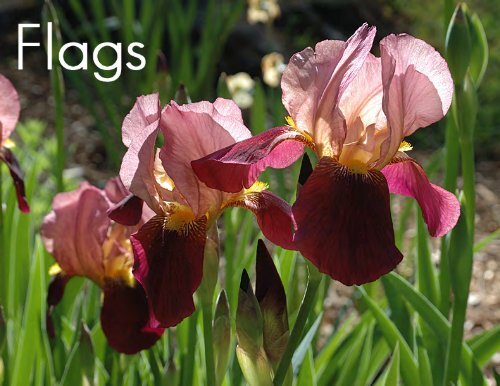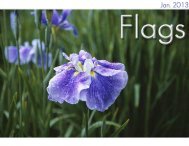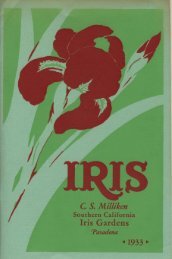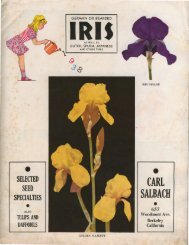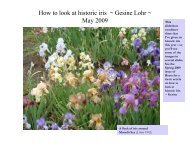Flags - Historic Iris Preservation Society
Flags - Historic Iris Preservation Society
Flags - Historic Iris Preservation Society
You also want an ePaper? Increase the reach of your titles
YUMPU automatically turns print PDFs into web optimized ePapers that Google loves.
<strong>Flags</strong>, Issue #6 October, 2012<br />
In This Issue:<br />
• Cover: ‘Indian Chief’ by Deb bender<br />
• From the Webmaster pg. 2<br />
• Looking Back: Eden Road <strong>Iris</strong> Garden 1959 pg. 3-4<br />
• The Digital Messenger: pg. 5<br />
• <strong>Iris</strong> Portraits, by Deb Bender: pg. 6-9<br />
• Definition Drift, by Robert Pries pg. 10-13<br />
• Varietal Spotlight: ‘Yves Lassailly’ pg. 14<br />
• Field of Dreams? By Cathy Egerer pg. 15-17<br />
• The <strong>Iris</strong>es of Jean Nicolas Lémon pg. 18-19<br />
• What’s in a Name? by Mike Unser pg. 20-21<br />
• Photo Essay: <strong>Iris</strong>es in Istanbul, pg. 22-24<br />
• Looking for more? / In the Next Issue pg. 25<br />
• Last shot: <strong>Historic</strong> irises, by Deb Bender<br />
From the Webmaster:<br />
Autumn is upon us in the Pacific Northwest, daylight is<br />
getting shorter, fall colors are appearing on the trees<br />
and nature is readying itself for the long, dark and wet<br />
winter ahead. We gardeners are preparing as well,<br />
finishing up fall clean up, iris planting, and getting beds<br />
put to rest for the season. Apologies for missing the<br />
July issue, but circumstances necessitated a break. I’m<br />
looking forward to getting back on track with this issue.<br />
So many of you wrote with words of encouragement<br />
and support while I was down, and I cannot thank you<br />
enough.<br />
Welcome!<br />
HIPS is happy to welcome Kate Brewitt as our new<br />
Display Garden chairperson.
Looking Back:<br />
Eden Road <strong>Iris</strong> Garden’s catalog for 1959<br />
Eden Road <strong>Iris</strong> Gardens was the domain of master<br />
hybridizer Gordon Plough, in Wenatchee, Washington.<br />
Mr. Plough started breeding irises in the 1940’s and<br />
quickly found renown for his advancements in color<br />
and form. He has left a long legacy of quality garden<br />
irises and is a favorite with many collectors of historic<br />
irises.<br />
In 1953 he introduced such memorable varieties of his<br />
own creation as ‘Cloud Dancer’, ‘Edenite’, ‘Gay Pal’,<br />
‘Lilac Festival’, and ‘Torrid Zone’, among others.<br />
Exuberant varieties, some of perfect tailored form,<br />
others bursting with ruffles and lace, all in a rainbow of<br />
colors. Many went on to win awards and acclaim, and<br />
to be used in further breeding by many others.<br />
Here are a few descriptions from the lovely 1959 issue<br />
of the Eden Road catalog. It offered many fine photos,<br />
as well as featured descriptions of hundreds of the top<br />
irises of the day. Here are descriptions of Mr. Plough’s<br />
introduction as well as a few others pictured above.<br />
‘Cloud Dancer’: (Cloud Parade X Native Dancer) We<br />
wanted to call this gay affair Party Doll, as the name<br />
seemed a perfect fit for it. As it was taken, we named it<br />
after the parents. This heavily ruffled and fluted white<br />
self has a bright tangerine-red beard. This is a fine<br />
color break from two pinks. The standards are crisply<br />
and firmly held and do not fully close, showing the<br />
beard to greater advantage. Fertile both ways.<br />
‘Edenite’: (Great Day X Sable Night) Not since<br />
Butterscotch Kiss bloomed here in the garden has an<br />
iris attracted so much attention as has Edenite. The<br />
name for this dusky dweller of Eden was suggested by<br />
Mrs. Thomas Powell of Spokane. The entire flower is a<br />
deep red-black with the falls having a sooty black<br />
appearance. It should prove a grand breeder as it is<br />
fertile both ways.<br />
‘Lilac Festival: Classy, lightly ruffled wide orchid self<br />
that shows its great breeding. The beard is in complete<br />
harmony, being a paler tint of orchid. Named in honor<br />
of Spokane’s great spring celebration. Stock scarce.<br />
‘First Flight’: (Plough, 1957) Color is Bishop’s violet.<br />
The nicely domed standards are upright are lightly<br />
suffused with buff. The falls are heavily arched and<br />
flaring. Edges of all petals are heavily crimped and<br />
fluted. Beard is yellow. Proving a fine breeder. HM. ‘58.<br />
‘Grand Coulee’: (Plough 1958) (Futuramic X Mary<br />
Randall) Very large heavily ruffled flower. Standards<br />
are a blend of pale tan and rose. Falls are pale tan,<br />
rose, and yellow. Beard is bright yellow.<br />
‘Angela Mia’: (Noyd, 1956) (Dixie Belle X Spanish<br />
Peaks) Ruffled snow white with a leathery texture. The<br />
white beard is long, heavy, an bristly. The flower opens<br />
slowly and is a knockout when fully out. Fine<br />
branching, blue-green foliage, and a real find.<br />
‘Bluebird Blue‘: (Fay, 1953) (Helen McGregor X<br />
Cahokia) Large and full very clear shade of medium<br />
blue. Non-fading. Beard is light lemon. A beauty from<br />
two great parents. HM ‘54
The Digital Messenger<br />
<strong>Iris</strong> News from around the Internet<br />
• The Pickle Barrel House garden has a website<br />
devoted to this historic structure in Grand Marais,<br />
MI, and the irises they are growing and<br />
preserving. Check it out at:<br />
https://sites.google.com/site/picklebarrelhouseiris<br />
garden/<br />
• The plantings at the Bertrand Farr Memorial <strong>Iris</strong><br />
Garden were stolen over the summer. Story and<br />
photos at:<br />
http://readingeagle.com/article.aspx?id=406032<br />
• The museum plans to relocate and replant the<br />
collection and is seeking donations of Farr<br />
varieties. If you are interested in donating contact<br />
Karin Wolkowitz at birdywire@Juno.com or 610-<br />
823-4156.<br />
• Results of the AIS photos contest for 2012 are<br />
now posted. Congrats to HIPS member Mike<br />
Fusaro on his many Honorable Mentions<br />
featuring historic irises. See all the great shots<br />
here: http://tinyurl.com/AIS2012winners<br />
Got a link to share? Drop me a line at:<br />
garden.of.mu@gmail.com<br />
• Anne Milner has created a website to highlight<br />
the National Collection of Arthur J. Bliss <strong>Iris</strong>es,<br />
which she holds at her home in Gloucestershire.<br />
What a treasure trove of information and photos<br />
she has collected too! Check it out here:<br />
http://www.blissiris.co.uk/<br />
Fall reminder: While doing your fall clean-up,<br />
be sure to note which clumps of historic varieties<br />
will need dividing next summer. When the call for<br />
Rhizome Sale donations rolls around again you’ll<br />
know just what you’ll have extras of should you<br />
wish to share.
Definition Drift<br />
By Bob Pries<br />
The <strong>Iris</strong> Encyclopedia project has been an exciting adventure<br />
into AIS history. When dealing with historic <strong>Iris</strong>es nothing is quite<br />
what it seems. One assumes that if one uses a word or symbol<br />
that one is familiar with, that it means the same today as it meant<br />
in 1939. Actually this is not the case.<br />
Horticultural Classification<br />
The most obvious difference is TB or tall-bearded iris. TBs were<br />
defined in in 1939 as irises over 17 inches tall and Dwarfs were<br />
up to and including seventeen inches. Of course the Dwarfs had<br />
not yet been split into miniature dwarfs and standard dwarfs. The<br />
median classes, of MTB, BB, and IB did not quite exist between<br />
17 and 27½ inches. I say not quite because the talls of the time<br />
were also sorted by bloom time with the class of IB. But IB, or<br />
intermediate bearded referred to bloom time and did not have a<br />
sharp cut-off of 27½ inches.<br />
The irony is that someone entering data for an iris on the<br />
encyclopedia may enter it as a MDB because dwarf is what it is<br />
called in the 1939 checklist where it is officially registered. But it<br />
actually is an SDB or even an MTB. That error is less likely, than<br />
the more common error of entering an iris as a tall bearded when it is actually an MTB, or BB. And we frequently get<br />
a mistaken classification of TB when it is actually an IB and vice versa. Since new people are likely to make the<br />
same mistakes as others have made, we have tried to resolve some of this misunderstanding, by not eliminating the<br />
incorrect entry, but referencing it. If you encounter one of these it may say originally registered as this, but now<br />
classified as that. Because the 39 checklist did not actually give descriptions, but gave references to descriptions,<br />
there are those that would argue that if it says it is a TB in the official checklist than it must be. But when the<br />
descriptions are provided, it is usually seen that our present definition no longer fits. The old definition has evolved
into a new one. The printed checklists are stuck in time. But the beauty of the <strong>Iris</strong> Encyclopedia is we can continue<br />
to update as definitions change.<br />
Verification<br />
In the Spring issue of Roots, Anner Whitehead wrote a great article calling attention to the fact that not all references<br />
can be trusted, even books by AIS presidents. Many are aware that inconsistencies in classification are often<br />
addressed in the R & Is. At the beginning of each year’s Registrations & Introductions one can find a list of errata<br />
and reclassifications. Usually the decennial checklists make all these corrections. But when there are sea changes<br />
in classification seldom do all of these reach the R & Is.<br />
Some years back the AIS appointed a blue-ribbon panel to reclassify <strong>Historic</strong> <strong>Iris</strong>es into the currently understood<br />
classifications. The Median <strong>Society</strong> was charged with this effort and famous hybridizers like Ben Hager and Bee<br />
Warburton took part. Their results were published in the Medianite and subsequently incorporated into the Median<br />
Checklist. Since most of these irises were put into the Encyclopedia from the Median Checklist they usually reflect<br />
the more current thinking. This often precipitates questions from individuals working on the Encyclopedia when they<br />
discover disparities in classification. In each case we add the cross reference.<br />
The <strong>Iris</strong> Register and the <strong>Iris</strong> Encyclopedia are often compared but have different missions. The Register presents<br />
the official registrations as printed in the checklists. One of its primary assets is it is immutable at least by viewers. It<br />
serves as an accurate archive of the official registration data. But much of this information may no longer be true,<br />
particularly because of definition drift.<br />
The <strong>Iris</strong> Encyclopedia is attempting to provide a complete up to date information resource on the Genus <strong>Iris</strong>.<br />
Although we attempt to provide the original official registration data, in the case of the 1939 checklist registrations,<br />
we are also seeking inclusion of the material from the references given. Also users can provide annotations. For the<br />
<strong>Iris</strong> historian this should prove to be an invaluable resource for the future.<br />
Bloom Season<br />
Unfortunately definition drift has not just occurred in the horticultural classifications. In the first three checklists; 29,<br />
39, and 49, bloom season was measured against the entire <strong>Iris</strong> year. In 1959 the bloom season was changed to be<br />
measured against the season of bloom for the class. In the earlier checklists VE for very early probably meant the<br />
plant was a pumila or MDB that bloomed very early in the year. VL for very late probably referred to a Japanese <strong>Iris</strong><br />
that bloomed at the end of the spring season of <strong>Iris</strong> bloom. But the currently defined terms could have VL for an
MDB blooming at the end of the MDB season but still way before the TBs; and VE for a Japanese could mean it<br />
blooms with the Siberians. Sadly many hybridizers still do not understand what the present definitions are, and even<br />
after 50 years they still report every MDB as VE or E and every Japanese as L or VL. This problem is evident<br />
because even in the last ten years the distribution in a class should have mostly midseason but about an equal<br />
number of VE and VL for that class.<br />
It would be impractical and unproductive to annotate every historical iris with a new code for bloom season. But<br />
digital data storage now allows us to do something even better. If an individual has an historic <strong>Iris</strong> blooming in their<br />
garden they can report the date, year, and location of the bloom period. If this were done on a regular basis by many<br />
people, it could provide interesting geographical information as well as temporal. Such phenologies (studies of<br />
bloom season) are being used by scientists to study climate change. But they could tell us a great deal about irises<br />
also. How does one motivate the 380 (in July) registered users of the Encyclopedia to report such things? By fall we<br />
expect to have 450 registered users. With such an army of interested irisarians all sorts of data could be<br />
accumulated. The Reblooming <strong>Iris</strong> <strong>Society</strong> has always had a hard time getting their members to report. But if you<br />
are a registered wiki user you can report bloom period very quickly and easily by just adding the information to the<br />
comment box on the cultivar’s page. You can do just one at a time or several. It does not require maintaining all<br />
sorts of notes and files. And the information that you may be saving on your own plants is always easy to find and<br />
benefits everyone.<br />
Botanical Classification<br />
Hopefully your eyes have not now just glassed over. Botanical names are another area that continues to change.<br />
New irisarians are often confronted by antique botanical terms. For example, Apogon and Evansia. These were<br />
coined by Baker in 1877. They probably haven’t been used by taxonomists for 50 years. We need to have a<br />
reference that links us to the current terminology and the Encyclopedia can do just that. While there are about 300<br />
currently accepted species the International Plant Names Index recognizes over 1200 synonyms and there are even<br />
some they have missed. It is taking a long time to get all of these into the Encyclopedia, but once there, they can be<br />
linked to each other. It will be easy to get an understanding of a history of the names and to be lead to the current<br />
terminology.<br />
The past is fascinating and gives incite to the present. But one expects <strong>Iris</strong> experts to be up to date while still<br />
cognizant of the history. Every good <strong>Iris</strong> researcher does a literature review. If the <strong>Iris</strong> Encyclopedia can have all the<br />
literature available in one place it would allow for a great deal of progress.
HIPS and the Encyclopedia<br />
All but one section of AIS has its own web on the Encyclopedia. HIPS, has the <strong>Historic</strong> <strong>Iris</strong> Web. How it develops is<br />
largely up to you. By being part of the Encyclopedia you have an enormous opportunity to capture for HIPS some of<br />
the over 2 million visitors to the Encyclopedia each year. Most people coming to the Encyclopedia have searched on<br />
<strong>Iris</strong>es but know little of the many different types. The more robust, informative and attractive the <strong>Historic</strong> Web<br />
becomes, the more capable it is to develop the interests in those viewers in historic <strong>Iris</strong>es. It also has the opportunity<br />
to clarify a great deal of <strong>Iris</strong> information that on its face appears miss-defined because of definition drift.<br />
Bob Pries is the <strong>Iris</strong> Encyclopedia manager, and can be contacted at robertpries@embarqmail.com<br />
Examples of Reclassed <strong>Historic</strong> <strong>Iris</strong>es<br />
Here are a few examples of historics that were reclassed<br />
in the Median Checklist:<br />
Variety: Originally: Reclassed as:<br />
Allah IB SDB<br />
Baria IB SDB<br />
Gajus TB MTB<br />
Honorabile IB MTB<br />
Sans Souci TB MTB<br />
Tid-Bit DB MTB<br />
Titmouse IB MTB<br />
Tom Tit TB MTB<br />
Ultra DB IB<br />
Warbler IB MTB<br />
Widget IB MTB<br />
Yellow Bantam DB SDB<br />
Zingara IB MTB
Varietal Spotlight:<br />
‘YVES LASSAILLY’<br />
(Cayeux, R. 1928) TB 40"+ L,<br />
From the Cayeux et LeClerc catalog for 1930: "Up to<br />
the present time, we have not seen anything yet in the<br />
way of this fine and distinct <strong>Iris</strong>; the delightful colors,<br />
the enormous size and the perfect shape of its flowers<br />
are unrivalled. S. pure white. F. wide, almost flat<br />
spreaded with a suffusion of soft sky-blue on the<br />
center; large throat strongly reticulated fawn; the<br />
whole of an exquisitely fresh appearance. As seen on<br />
the figure, the firm stems 4 feet high, well branched,<br />
bears 4 to 5 flowers expended at the time.<br />
Exceedingly free, a grand toned <strong>Iris</strong> for landscape."<br />
[sic]
Field of Dreams?<br />
Transforming a Weedy Mess in to an <strong>Historic</strong> <strong>Iris</strong> Garden<br />
By Cathy Egerer<br />
Grand Marais, MI<br />
“There is nothing like impossibility for getting a gardener’s energies up.”<br />
– Henry Mitchell, renowned gardening author<br />
Henry sure had it right, I thought as I looked out over<br />
the weed-choked field that I hoped, with enough<br />
energy, might become a garden of historic irises. At<br />
the moment, all I could see was the “impossible” part.<br />
Michigan’s Upper Peninsula turns out to be a good<br />
place to grow irises. Our soil is sandy, our winters are<br />
cold enough that iris borers don’t like it here, and while<br />
the summers are short, the days are long. Several<br />
years ago, I helped my friend Nancy plant an historic<br />
iris garden at the Pickle Barrel House, our funky local<br />
museum. (It’s now on the HIPS register.) Thus I was<br />
bitten by the iris bug, and scattering a few here and<br />
there among my other garden plants hadn’t quieted<br />
the itch. I really wanted a garden area that was<br />
devoted to historics. I particularly wanted a bed of<br />
Grace Sturtevant irises – their soft colors and graceful<br />
forms are very appealing, and I admire her work as the<br />
first woman to hybridize irises at a time when women just didn’t do things like that. Thank you, Miss Sturtevant!<br />
But the only available sunny spot was an empty field next to our house, chock-full of quackgrass with a smattering of<br />
tansy, poppies, the much-hated spotted knapweed, and a few long-abandoned tall purple irises growing defiantly<br />
amidst the grass, since identified as the venerable ‘Lent A. Williamson’. Not a promising prospect. It’s said that<br />
thirty years ago the previous owners had a garden here, not that you’d have known it by looking.
Well, first things first. Lent A. came up and was moved elsewhere, and the rest had to go. Luckily, our friend Chris<br />
has a tractor and likes to use it, and he was happy to come over and scrape off the top six inches of junk. Now I<br />
had a roughly U-shaped area of old beach sand, laid bare, that connected the ends of two existing garden beds.<br />
Nancy, who has probably forgotten more about gardening than I will ever know, pointed out that even irises need a<br />
bit more than just beach sand, so soil improvement was in order. Another stroke of luck: there is a long-closed<br />
sawmill in the area. The owner lets gardeners take away composted sawdust for their gardens. Also I had some old,<br />
falling-apart straw bales left from last year’s garden, and I could get my hands on a yard or so of topsoil. Another<br />
friend has a tiller, and for the promise of a couple loaves of homemade bread, it was mine for an afternoon. I was in<br />
business.<br />
While I was rounding up my witches’ brew of<br />
soil improvers, the quackgrass decided to<br />
make another appearance. It was thinner,<br />
but still abundant, and it led to a tough<br />
decision: this was Round-Up Time. Two<br />
weeks later the quackgrass was dead and<br />
ready to rake off. It’s not gone for good, but<br />
at least now I have a fighting chance.<br />
By late July, I had a newly-tilled garden area,<br />
nearly ready to plant. I’d been scouring the<br />
Internet and the iris catalogs since spring,<br />
and thanks to a number of generous HIPS<br />
members, I had 15 or so Sturtevant irises on<br />
the way, along with about 150 other varieties<br />
that I “just had to have”. Moderation isn’t my<br />
strong suit.<br />
Besides helpful friends and HIPS members, I have generous neighbors, too. I came home one day to find surveying<br />
stakes at the edge of the field. The neighbors needed to have a new survey done for another matter, and it turns out<br />
I had scraped to within eighteen inches of the actual property line. Being kind people, they wished me well and said
they can’t wait to see the final result. Whew! We’ve agreed to install cedar posts with bluebird houses on the<br />
property line, which will be a nice addition to the garden.<br />
The entire garden area got bordered with plastic edging (take that, quackgrass!) and now came the fun part: laying<br />
out the beds. I decided on a roughly chronological arrangement, with a few simple paths made of stepping stones.<br />
<strong>Iris</strong>es from the 1920s and earlier flow into the 1930s, which move along to the 1940s, etc. and on up though the<br />
1970s. The Sturtevant bed is horseshoe-shaped, and sits in the center of the garden. Varieties of peonies (another<br />
of my addictions) provide a border along some of the paths, with irises interspersed between and behind them. And<br />
wonder of wonders, there is still plenty of room for more irises! Yes! Ahem.<br />
I decided early on to try and label each variety with something I could see from the path. Buried tags have a way of<br />
disappearing around here; chipmunks and crows carry them off, or they work themselves deeply into the ground and<br />
can’t be found. Sometimes they just vanish. Garden gremlins, maybe? Pre-printed labels are expensive, but I had a<br />
big bag of 2x3-inch white plastic tags from somewhere and a UV-resistant black paint marker. I ended up making<br />
my own labels and gluing them onto zinc rose markers with Plumbers GOOP adhesive. The marker doesn’t fade<br />
easily, and if it does, it’s easy to touch up. I also buried a tag with each iris as an insurance policy.<br />
By mid-September, the irises were planted and labeled. Now comes the hard part: waiting for spring!
Lémon <strong>Iris</strong>es<br />
Faustine - 1859, IB M B3L.<br />
A classic neglecta with light blue standards over<br />
velvety falls, heavily veined white and darker purple.<br />
Fries Morel – 1840 TB M<br />
From Annales de Flore et Pommone, 1840: "S.<br />
chamois yellow; F. yellow reticulated on the haft, with<br />
bright velvety maroon at the summit of the blade."<br />
Jacquesiana - 1840, TB L S9M<br />
From the Cornell Extension Bulletin 112: "Color effect<br />
a bright russet-crimson, velvety bordeaux bicolor. The<br />
bronzed orange beard is fine, dense, and projecting.<br />
This plant is a vigorous grower, and has lax, slender,<br />
deep green foliage, tinged at the base. Its excellent,<br />
velvety blooms are freely produced and well carried on<br />
long stems. Rating 80."<br />
Mme. Chereau – 1934, IB M Y5M<br />
From the Cornell Extension Bulletin 112 (1925): "Color<br />
effect a lavender-white plicata. S. White bordered<br />
hortense violet, beautifully ruffled. F. white, with deeper<br />
hortense violet, slightly purplish tinged plications.<br />
The base of the blade becomes cream-white with a<br />
waxen sheen. The styles are showy, hortense violet,<br />
and the beard is dense, white, and yellow tipped. The<br />
growth is moderate, and the foliage lax, slender, and<br />
green. The flowering stalks are tall and well branched,<br />
and carry the smallish blooms well above the compact<br />
foliage. The delicate coloring, the clear penciling, and<br />
the symmetrical form of the individual bloom have not<br />
been rivaled by the productions of the modern<br />
hybridist. This is one of the best ten, and absolutely<br />
lovely, despite its low rating of 74."<br />
Othello – 1937, TB S3D<br />
From Biltmore Nursery catalog for 1912: "This has<br />
standards of a rich, fine blue and falls of intense,<br />
velvety dark purple. The foliage is particularly good.<br />
Othello is one of the largest of the Neglecta sorts,<br />
reaching a height of 30 inches or more."<br />
Victorine – 1936, TB M W3D<br />
From The Wing Seed Co. catalog for 1920: "A beautiful<br />
and distinct <strong>Iris</strong>, very scarce. S. snow-white oddly<br />
flecked deep velvety violet, strongly tigered at the<br />
base; style arms snow-white; F. deep velvety violet of<br />
beautiful texture with an irregular border of white<br />
Candelabrum-shaped flower formed of long divisions.<br />
Twenty-seven inches."<br />
You can read all about the history of the Lémon family<br />
and their irises in Clarence Mahan’s book Classic<br />
<strong>Iris</strong>es, and the Men and Women Who Created Them.
What’s In a Name? ‘Clair De Lune’<br />
By Mike Unser<br />
The arts have traditionally been a source of inspiration for iris hybridizers, and those works considered to be classics<br />
have long been mined. We’ve seen just about every character in Shakespeare’s plays used, as well as those from<br />
legends and folktales. Classical music is not so prevalent in the history of iris names, but ‘Clair de lune’ stands out<br />
as one of the few. The French term for moonlight, this is a very poetic name, unsurprisingly, as "Clair de lune" was<br />
inspired by a Paul Verlaine poem of the same name. “Clair de lune” (originally titled "Promenade Sentimentale") is<br />
the name for the third movement of Claude Debussy’s masterwork, the Suite Bergamasque. Wikipedia tells us:<br />
The Suite Bergamasque was first composed by Debussy around 1890, but was significantly revised just<br />
before its publication in 1905. It seems that by the time a publisher came to Debussy in order to cash in on his<br />
fame and have these pieces published, Debussy loathed the earlier piano style in which these pieces were<br />
written. While it is not known how much of the Suite was written in 1890 and how much was written in 1905,<br />
we do know that Debussy changed the names of at least two of the pieces.<br />
Considered one of Debussy’s most popular compositions, it is a soft, dreamy and romantic piece with a hint of<br />
melancholy, as lovely as its name, and a perfect moniker for a flower that would evoke these same themes. The<br />
Verlaine poem sets the tone for the music:<br />
Your soul is as a moonlit landscape fair,<br />
Peopled with maskers delicate and dim,<br />
That play on lutes and dance and have an air<br />
Of being sad in their fantastic trim.<br />
The while they celebrate in minor strain<br />
Triumphant love, effective enterprise,<br />
They have an air of knowing all is vain,—<br />
And through the quiet moonlight their songs rise,<br />
The melancholy moonlight, sweet and lone,<br />
That makes to dream the birds upon the tree,<br />
And in their polished basins of white rock<br />
The fountains tall to sob with ecstasy.
You can listen to a performance of this wonderful<br />
piece of music here:<br />
http://www.youtube.com/watch?v=ZIsQPdC9YnY.<br />
And while that sets a mood let me tell you about two<br />
iris varieties bestowed with this lovely appellation:<br />
‘Clair De Lune’ (Wareham, 1934) TB M B1L From<br />
National <strong>Iris</strong> Gardens catalog for 1937: "A new clear<br />
light blue-lavender self, with a deeper area to the<br />
center of the F., and a rich red-gold beard."<br />
'Clair De Lune' (Whiting, R 1954). Sdlg. 4711. TB, 36"<br />
(91 cm), M-L. Color Class-Y1, Yellow self, (Wilson<br />
60/32), slightly deeper beard. (('Purissima' x 'Matula')<br />
x 'Gilt Edge') X 'Glad Tidings'.<br />
One a soft yellow, one a soft blue. I’m unsure if<br />
Agnes Whiting’s variety is still extant (please let me<br />
know if you grow it), but Mr. Wareham’s is growing<br />
happily in the Pacific Northwest, as well as the many<br />
gardens I have passed it along to. It is a lovely soft,<br />
silvery blue-lavender, quite similar to the famous<br />
Dykes Medal winner ‘Great Lakes’. As a matter of<br />
fact they are nearly indistinguishable until grown sideby-side<br />
and compared on details. ‘Clair De Lune’ has<br />
the wonderful attribute of surviving – even thriving - in<br />
neglect. A very hardy grower and reliable bloomer, it<br />
quickly makes a beautiful clump filled with blooms.<br />
The flowers have a soft tone as befits their name and<br />
sweet fragrance to go with it. The golden beard lights<br />
up the heart and soft brown reticulations adorn the<br />
hafts. Seek out this excellent old variety if you’d like to bring a note of classic harmony to your iris border.
Looking for more on<br />
<strong>Historic</strong> <strong>Iris</strong>es??<br />
• While we wait for spring, why not take a virtual<br />
tour of Presby Memorial iris Gardens thru the<br />
magic of Flickr, the photo sharing website. Check<br />
out this link for a gallery of photo taken there of<br />
the gardens and the flowers. And share yours<br />
with us on Facebook.<br />
http://tinyurl.com/presbypics<br />
<strong>Flags</strong> is a publication of the <strong>Historic</strong> <strong>Iris</strong> <strong>Preservation</strong><br />
<strong>Society</strong>. All content remains copyright of the authors<br />
and is used by permission. Permission to reprint<br />
articles is granted so long as credit for source is given.<br />
Please send your questions, comments, suggestions,<br />
corrections or anything else you’d care to share with us<br />
to: garden.of.mu@gmail.com<br />
Please feel free to share this file!<br />
Fare Thee Well<br />
HIPS bids a fond farewell to Laetitia Munro, who has<br />
served as chairperson of our Display Garden program<br />
for many years. Laetitia has been very dedicated and<br />
under her leadership the Display Garden program<br />
expanded to include dozens and dozens of gardens in<br />
the US, as well as Canada and Europe. Just because<br />
she is stepping down from the Board she is not leaving<br />
HIPS, and I look forward to bringing you more of<br />
Laetitia’s articles in future issues of <strong>Flags</strong>.<br />
Follow HIPS on Facebook - New photos of historic<br />
irises are posted almost daily. Why not share yours!<br />
http://www.facebook.com/historiciris<br />
In the next issue:<br />
Photo Essay: The <strong>Iris</strong>es of Agnes Whiting<br />
What’s in a name?<br />
… and much more!


